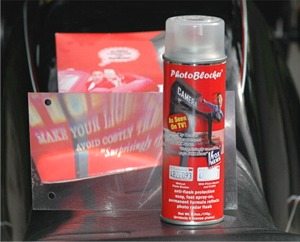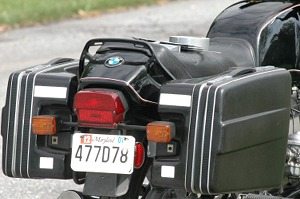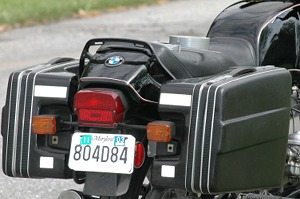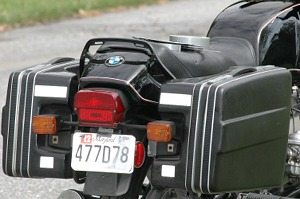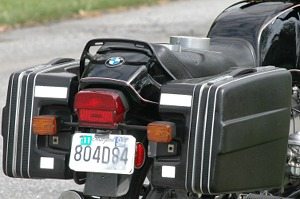Photo Blocker Spray
You may believe that red light cameras and photo radar are part of the Trilateral Commission’s conspiracy to turn the proletariat into tools of the military-industrial-banking complex.
Or, you may think that drivers who are caught by red light cameras deserve what they get. But everyone’s reaction is the same when the Postman knocks with a hundred-buck ticket.
They’re pissed!
Red light cameras are big business. It’s not uncommon for the systems to be installed and managed by large corporations, who by the way process the tickets and send them to the offender while taking a slice of the proceeds and passing the rest back to the local city or county government.
Matt Labash’s excellent article “Inside the District’s Red Lights” from the Weekly Standard (April 2002) details the use of red light cameras in Washington, D.C. In the first couple of years of use, red light cameras in Washington, D.C. generated over $15.5 million in revenue for the District.
No one seems bothered that “A private company is given police power to ticket citizens, has a monetary interest in generating as many tickets as possible, and, despite its low success rate, is often allowed to do so with minimal or no police supervision.”
Governments like to find alternate sources of revenue and they like to spend money, so the allure of free cash in the form of red light camera revenue is irresistible, and the devices are becoming very popular.
And they see no problem with a private company being given police powers to ticket citizens, has a monetary interest in generating as many tickets as possible, and, despite its low success rate, is often allowed to do so with minimal or no police supervision
Have they decreased accidents? Who cares when all that money is flowing into the coffers!
A rather convincing study about the efficacy of red light cameras was conducted in 1995 by David Andreassen for the Australian Road Research Board. “A long term study of Red Light Cameras and Accidents”, (ARR 261) concluded that accident rates at intersections can increase when red light cameras are used.
Where to Buy Photo Blocker Spray
Check Reviews & Prices on AmazonSee More: Motorcycle Accessories, Motorcycle Tire, Motorcycle Helmets
The study covered a 10-year period and concluded that the use of cameras for enforcement “did not provide any reduction in accidents, rather there have been increases in rear end and cross-street accidents”.
Some studies indicate that increasing the length of the yellow light actually decreases the accident rate at intersections (See “Red Lights, Loot and the Law” by Csaba Csere, Car and Driver, September 2001).
But longer yellows don’t raise any revenue; in fact, it’s been postulated that the length of time that the traffic lights show yellow has actually been decreased in some cities, and the conspiracy theorists say this is to help increase the revenue generated by the red light cameras and to hell with public safety.
Which brings us to Photo Blocker. This product is a clear coating that is sprayed on a clean license plate. It’s claimed to “reflect photo radar flash” and that it will “make your license plate invisible to cameras”.
It’s probably illegal to mess with your license plate, but it would probably be almost impossible to tell that the plate was treated with the clear Photo Blocker spray. The idea is that the spray will cause the license plate to reflect light back to the camera, over-exposing the photo and making the plate impossible to read by the photo camera.
Phantom Plate, the company that markets Photo Blocker, also sells a product called the “PhotoShield”. This device is made from various shapes of translucent plastic that have what appears to be some sort of magnifying qualities.
A PhotoShield is supposed to be placed over the license plate to help obscure the characters on the plate by distorting the way the plate’s letters or numbers appear in the camera.
Do these products work as advertised? We did a very unscientific study to see if we could tell. Since photo radar cameras are set at different heights and distances from traffic, and can either be on the right or left sides of the road (depending upon which country you’re in), we standardized on our own distance and height just for comparison purposes.
We don’t know what exposure values are used by the various roadside radar cameras, and apparently some of the cameras don’t use a flash. Since the Photo Blocker spray is supposed to work by reflecting back the camera’s flash, if no flash is used, we would assume that the Photo Blocker would be ineffective. Keep that in mind next time your riding in red light camera territory.
The printed and online marketing literature for the Photo Blocker and PhotoShield products show various before and after photos. Some of the photos appear to be taken from directly behind the license plate.
We don’t think there are many red light cameras that are configured to take their photos from directly behind a license plate, so we’re not sure if before/after photographs taken from directly behind the license plate is a valid method to demonstrate the effectiveness of the product.
Most of the radar cameras we’ve seen in Montgomery County, Maryland and in downtown Washington, D.C. are set high up on traffic poles off to one side of an intersection.
Something to consider is that the angle of the flash will probably bounce the light off the plate in an opposite but equal angle. Remember high school geometry? It took me 3 semesters to pass it, but I do remember something about the angle of incidence equals the angle of reflection.
So it would seem logical that if the camera and flash are above and to the side of the license plate that the light from the flash will reflect off at an equal but opposite angle. If this is true, then even if the license numbers were painted on a mirror, they’d still be visible to the camera, no? You scientific brains can tell me if we’re wrong or not.
We set the camera 10 feet to the right of a parked motorcycle, at a distance of 25 feet at an angle of 22.5 degrees from the rear of the bike. The camera’s lens was 6 feet high.
We used a Nikon D70 digital camera with a Nikon 80-200 f2.8 AF-D ED lens set at its 200mm focal length, and a Nikon Speedlight 800 flash (Nikon’s most powerful), set to use fill-flash. The flash fired on each photo.
The motorcycle shown in these photos faces north; it was mid-morning, and the sun was up in the east on a sunny and clear day with low humidity. We tried various exposure settings and compared the photos, but there didn’t seem to be any noticeable difference in the quality of the photo or in the visibility of the license plate, so we settled on f8 at 1/125 second exposure, which is a “classic” sunny day camera setting.
We used two expired Maryland license plates to compare the application of the Photo Blocker spray. Both plates were cleaned with soap and water and dried prior to the study, and they were in almost new condition. One plate was sprayed with the Photo Blocker following the directions, which indicate that several coats should be applied until a gloss coat appears on the plate.
We used the two plates so that we could leave the motorcycle and camera in exactly the same position between photos and so that we’d have a treated and untreated plate for more study if warranted.
The photos below show the results. These photos are un-retouched with the exception of a 10% sharpening in Microsoft PhotoDraw. Photo 1 is the untreated license plate. Photo 2 shows the license plate treated with Photo Blocker. Photo 3 shows the untreated license plate with the PhotoShield lens attached.
Photo 4 shows the license plate treated with Photo Blocker and the PhotoShield lens attached. The PhotoShield lens had a slight bow on the right side, causing the slight distortion of the numbers on the plate in photos 3 and 4. We assume that if this distortion could be amplified over the plate that it might cause the numbers to be unreadable.
Photo 1: Not treated with Photo Blocker; noPhotoShield lens.
Photo 2: Treated with Photo Blocker coating; noPhotoShield lens.
Photo 3: Not treated with Photo Blocker; PhotoShield installed.
Photo 4: Treated with Photo Blocker coating; PhotoShield installed.
We didn’t have the capability of mounting the camera at more than 6 feet high or at various distances from the motorcycle, so results may vary.
We have no comment on the efficacy of these products and will leave it up to the reader to interpret the results. If you have any comments on this product or how this study was conducted, please see the comments section below.
More Information: UK Gatso information | Burnt and destroyed Gatsos | Flash Jammer
|
wBW Product Review: Photo Blocker License Plate Spray |
|
| Available From: Phantom Plate | Suggested Retail Price: Spray $29.99; Motorcycle Photo Shield $22.99; S/H $10.30 |
| Product Comments: Clear spray for license plates, claimed to block photographs taken by red light cameras, aka “Gatso”. The PhotoShield is a translucent plastic lens for license plates claimed to “defeat both photo radar and the red light overhead cameras”. | |
| More: Motorcycle Accessories Page | Motorcycle Safety Page | See below for comments from owners | |
Note: For informational use only. All material and photographs are Copyright © webWorld International, LLC – 2000-2011. All rights reserved. See the webBikeWorld® Site Info page. NOTE: Product specifications, features and details may change or differ from our descriptions. Always check before purchasing. Read the Terms and Conditions!
Where to Buy Photo Blocker Spray
Check Reviews & Prices on Amazon
See More: Motorcycle Accessories, Motorcycle Tire, Motorcycle Helmets
Owner Comments and Feedback
Not all comments will be published (details). Comments may be edited for clarity prior to publication.
NOTE: No further comments on this product, thanks.
From “S.L.” (7/09): “I tried it. It doesn’t work. Use the money that you would spend on this spray to help pay for the ticket you’re bound to get soon or later. I used it on all three of my cars but recently got a photo ticket while driving one of those cars. I got a copy of the picture along with the ticket and there was no trouble at all seeing the plate perfectly. In my opinion, based on the picture it does not work.”
From “M.K.” (2/09): “I bought several cans of Photo Blocker for myself and as gifts for friends & relatives. I applied 5 coats to my plates, letting it dry between coats. I’ve had to pay 2 tickets so far at $100 a pop.”
From Photo Blocker: “Dear Rick, While gratified by the large volume of attention we receive, we treat every review of our products as an opportunity to explore the public’s concern and thus thank you for your review of PhotoBlocker Spray on your web site.
At Photoblocker.com, we owe our success to our customers and deem concerns reflected in the media reviews of utmost importance. We also appreciate your aspiration to fairness shown by giving us a chance to comment on the review and explain the results you achieved based on the equipment and method used.
We have no doubt your intentions were good. However, using a personal digital camera as an alternative to a Traffic Camera could only lead to a wrong conclusion. Since the purpose of our products has never been to defeat personal digital cameras, we would like to draw your attention to the flawed test parameter behind the conclusion you reached.
The correct way to test the effectiveness of PhotoBlocker Spray, as attested by many independent investigators, is to use actual photo-radar equipment. That is what Fox News investigative reporters, Denver City Police Department, Dutch Police, South African Police, Swedish TV, Australian TV and Norwegian newspapers did. Ideally, the test vehicle has to be in motion since in reality motorist would be driving past a fixed traffic camera any where from 35-60 miles per hour. We believe the vehicle was not in motion during your test and the pictures were taken from just a few feet away.
(Editor’s Note: For reference, and as mentioned in the article above, the camera was offset 10 feet to the right of a parked motorcycle, at a distance of 25 feet back at an angle of 22.5 degrees from the rear of the bike. The camera’s lens was 6 feet high. The camera was set at f/8 and 1/125, a typical outdoor daylight setting).
The use of a personal digital camera for the test is unjustifiable for the following reasons. A personal digital camera in use will take a few seconds to measure the light, adjust exposure, shutter speed, focus and flash level before taking a picture. Under those circumstances, the pictures tend to be legible as the camera was given enough time to calculate the best setting for a perfect picture.
On the contrary, a traffic camera works in a totally different way and does not have the luxury of a few seconds to establish the correct exposure, focus, shutter speed and flash level before taking a picture. Traffic cameras are programmed to take pictures on set parameters such as distance and ambient light. Cars zooming past are photographed in a split second.
This is where PhotoBlocker spray comes in to play. By changing the amount of light reflected back to the camera, it is possible to render the picture illegible and blind the traffic camera. Additionally, the flash technology used will not be comparable. Traffic cameras use a high intensity flash that is much stronger than a personal digital camera.
We assert, backed by results from independent investigators, there in only one correct way to test the effectiveness of PhotoBlocker spray. One must use actual photo- radar cameras. PhotoBlocker has become the best selling anti-photo radar spray in the world because it is effective. Additionally, our complaint or product failure rate is less than ½ % of total sales in the past few years.
Our goal at PhantomPlate is to help law abiding motorist avoid unjust traffic tickets. We are proud to say we have sold over 500,000+ cans sold worldwide and helped protect over 2,000,000 license plates in 23 countries. We estimate that we have saved motorist from several hundred million dollars in fines. We have repeat customers and 99% customer satisfaction rating.
Our customers list includes law enforcement people and the same guys who install and operate the red-light/speed cameras. It is common knowledge that these red light and speed cameras are installed for revenue purposes in the name of safety. It is private companies and the insurance industry that benefit from overzealous photo-radar programs by entrapping the average driver and finding him/her guilty until proven innocent.
In summary, we would like to clarify our message so that your readers are not misled. We are not claiming our products to be effective 100% of the time. All we are saying is, based on several independent test results the products have been proven to work. For less than $30.00 a can even if PhotoBlocker Spray saves a customer one ticket it has paid for itself. All we ask is to be judged on the merits and conclusive independent test shown (on our website).
I thank you for allowing us to share our concerns and inform the driving public. To show our gratitude, we would like to extend a special offer to your readers. We will provide FREE of charge our complete e-Book “Fight Back: How to fight red light and speed camera tickets” www.FightBackUSA.com. Simply send an email to FightBack@PhantomPlate.com and your e-Book will be delivered to your inbox in less than a day. The tips found in the e-Book have helped several thousand motorists beat their tickets in the court of law
Sincerely,
Joe Scott
VP of Marketing
PhantomPlate Inc.
From “M.C.”: “I made a rare evening trip into DC over the weekend and was going along MacArthur Blvd. at about 40mph and was hit with a sudden “FLASH” of light. I strongly suspect that I’ll be getting something
in the mail from the DC government soon along with a request to send them some money.
Sadly, I already had a can of PhotoBlocker sitting on the counter in the garage, so today I (finally) got off my dead arse and treated several of my license plates with PhotoBlocker according to the can’s instructions.
Enclosed are several photos showing a treated license plate with obviously no results…”
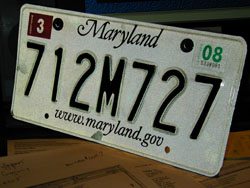 |
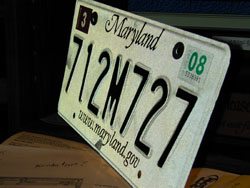 |
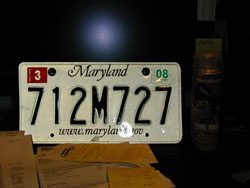 |
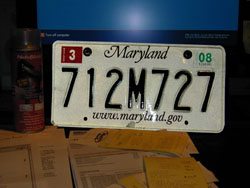 |
From “G.G.”: “I recently purchased Photo Blocker from Phantomplate on the internet. In order to get an idea of it’s effectiveness, I took three before, and three after pictures. Each picture was taken from within an inch or two of the same places, before and after. ( placed a mark on the ground, and kept the plate in the same location) I took close up pictures from directly behind, 45 degrees left, and 45 degrees right. Each picture was taken in darkness using flash. When I compared my pictures, I saw no difference. Every picture of the plate was clear and readable.
I wondered if I got a defective can, since there was no rattle in the can to agitate the paint mixture. I also wondered if this were just nothing more than Krylon Crystal Clear with a new label attached.
My opinion is that Photo Blocker is just another in a series of rip offs that are so common these days. Sort of like the gadgets that promise higher fuel mileage in your vehicle, with a very fine print disclaimer that “results may vary.” When this disclaimer is attached, it basically says that when you get no favorable results, that your case is unique. I believe in fact that the lack of favorable results is the rule.”
From “M.R.”: “Just wanted you to know – I used Photo Blocker on my plates and received a ticket anyway. It was dark so a flash was used, but the plate was clearly visible. Camera mounted up high and to the right of the vehicle. You’re right, it’s (photo radar) all a money-making scam . I didn’t go through the light, rather, made a right on red. But it interpreted what I did as going through the light.” Thanks for your comments, M.R.
Other WebBikeWorld Accessory Posts


